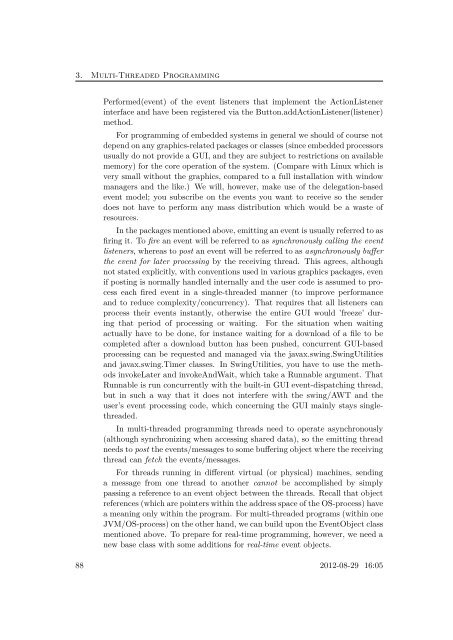JAVA-BASED REAL-TIME PROGRAMMING
JAVA-BASED REAL-TIME PROGRAMMING
JAVA-BASED REAL-TIME PROGRAMMING
Create successful ePaper yourself
Turn your PDF publications into a flip-book with our unique Google optimized e-Paper software.
3. Multi-Threaded Programming<br />
Performed(event) of the event listeners that implement the ActionListener<br />
interface and have been registered via the Button.addActionListener(listener)<br />
method.<br />
For programming of embedded systems in general we should of course not<br />
depend on any graphics-related packages or classes (since embedded processors<br />
usually do not provide a GUI, and they are subject to restrictions on available<br />
memory) for the core operation of the system. (Compare with Linux which is<br />
very small without the graphics, compared to a full installation with window<br />
managers and the like.) We will, however, make use of the delegation-based<br />
event model; you subscribe on the events you want to receive so the sender<br />
does not have to perform any mass distribution which would be a waste of<br />
resources.<br />
In the packages mentioned above, emitting an event is usually referred to as<br />
firing it. To fire an event will be referred to as synchronously calling the event<br />
listeners, whereas to post an event will be referred to as asynchronously buffer<br />
the event for later processing by the receiving thread. This agrees, although<br />
not stated explicitly, with conventions used in various graphics packages, even<br />
if posting is normally handled internally and the user code is assumed to process<br />
each fired event in a single-threaded manner (to improve performance<br />
and to reduce complexity/concurrency). That requires that all listeners can<br />
process their events instantly, otherwise the entire GUI would ’freeze’ during<br />
that period of processing or waiting. For the situation when waiting<br />
actually have to be done, for instance waiting for a download of a file to be<br />
completed after a download button has been pushed, concurrent GUI-based<br />
processing can be requested and managed via the javax.swing.SwingUtilities<br />
and javax.swing.Timer classes. In SwingUtilities, you have to use the methods<br />
invokeLater and invokeAndWait, which take a Runnable argument. That<br />
Runnable is run concurrently with the built-in GUI event-dispatching thread,<br />
but in such a way that it does not interfere with the swing/AWT and the<br />
user’s event processing code, which concerning the GUI mainly stays singlethreaded.<br />
In multi-threaded programming threads need to operate asynchronously<br />
(although synchronizing when accessing shared data), so the emitting thread<br />
needs to post the events/messages to some buffering object where the receiving<br />
thread can fetch the events/messages.<br />
For threads running in different virtual (or physical) machines, sending<br />
a message from one thread to another cannot be accomplished by simply<br />
passing a reference to an event object between the threads. Recall that object<br />
references (which are pointers within the address space of the OS-process) have<br />
a meaning only within the program. For multi-threaded programs (within one<br />
JVM/OS-process) on the other hand, we can build upon the EventObject class<br />
mentioned above. To prepare for real-time programming, however, we need a<br />
new base class with some additions for real-time event objects.<br />
88 2012-08-29 16:05

















